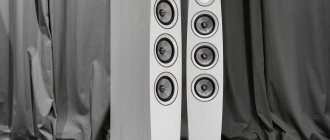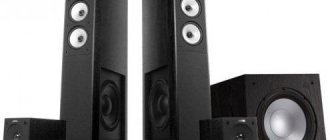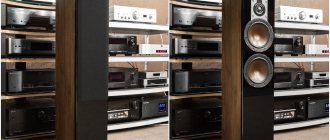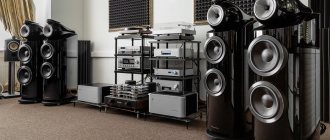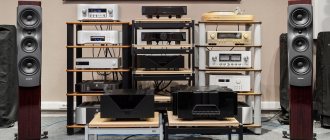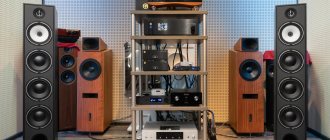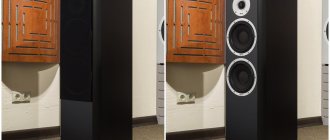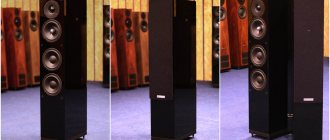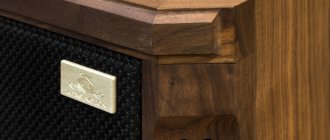The Klipsch company does not waste time on trifles and positions even younger models as reference ones (of course, in their price category). At the same time, within the model range of any company there is its own absolute reference, which determines the signature character of the sound and sets the direction for development for all other series. Monsters like Klipschorn or La Scala are not suitable for this role, because these are modern incarnations of legendary models - a completely different genre. The current flagship of the line is the Klipsch RF-7III. This is the very desired reference for Reference.
Number three
The Roman numerals III in the model designation clearly hint that this is not the first version of the flagship. At the same time, it is equally obvious that the key technological solutions of this model, at least externally, look the same as those of speakers with a much more modest price tag.
Let's combine these two facts and come to the conclusion that modern junior Klipsch models are close relatives of the RF II acoustics. However, the price gap between the younger Reference and older RF is quite significant, and this is a reason to look in more detail at what exactly the Klipsch RF-7III is superior to all other models.
Hear, not see
Distinguishing Klipsch speakers from each other by eye without checking the nameplates is a special art that I personally have not yet mastered. Whether this is the Reference series, or the Reference Premier, or the flagship RF pair, I can’t figure it out right away. At first glance, they differ only in size and finishing, which can only be seen up close.
For this reason, it is not possible to determine “from photographs” what new and progressive was used in the RF-7III. But I’ll give you a big spoiler right away: it won’t be difficult to distinguish the speakers from each other by ear. This provokes a logical question: “what was done, if everything is the same on the outside, but the sound quality is completely different?!”
I answer point by point. The horn looks very familiar indeed and in essence it has not changed. This is a square Tractrix with an opening of 90° vertically and horizontally. Its invisible part - the driver - has been significantly improved and has little in common with the drivers that are installed in younger versions of speakers.
The magnet of the RF series is much larger, and during the latest modification, special attention was paid to the phase-equalizing element, which is responsible for matching the emitter with the horn. As a result of the modification, the frequency response at the listening point has become smoother than it was with the previous version of the driver.
The mid-bass speakers also look absolutely familiar. And in the same way they have nothing in common with the speakers of the lower series except for the branded copper color. In lower-end speakers, the polymer material is coated with copper, while metal-ceramics are also used here. As a result, the mass of the moving system is lower, rigidity is higher, there is less deformation of the cone, and the sound is more accurate and cleaner.
The connection circuit for the low-frequency emitters is not advertised by the manufacturer; only one crossover frequency of 1,300 Hz is indicated, which indirectly indicates a two-way design. And judging by the emission spectrum of the middle and lower speakers, we have quite traditional 2.5 bands. One way or another, it doesn’t even smell like three-stripes, and this is quite in the spirit of Klipsch.
No dogmas or prejudices - only practicality, rationality and work for results. For the company's engineers, sound is clearly primary, and common ideas about what design the flagship acoustics should have are sent on a long journey on foot with a well-known destination. Grandpa Paul would have approved of this approach.
It is curious that the body is divided into two independent compartments, each of which has its own slotted bass reflex, again designed like a Tractrix horn. Separating the housing solved the problem of standing waves and eliminated the resonances that arise when the radiation of two speakers overlaps each other.
The horn exhaust eliminates turbulence and other transient processes that inevitably occur at the output of the bass reflex. To be fair, we note that the younger models have exactly the same ports, there are no differences here, we are simply stating the fact that they are also present in the older one.
Speaker system Klipsch RF-7 III Cherry
The Klipsch RF-7 III speaker system is a prime example of how demanding the company is in the manufacture of its speakers. Remember that same reference sound? We, too. The RF-7 III hull is made in the USA and is rightfully the pride of the craftsmen from Hope, Arkansas. The model is made in full accordance with the ideas of Paul W. Klipsch (PWK). The flagship model Klipsch RF-7 III belongs to the third generation of the iconic floor-standing “sevens” and is a fairly strong contender in its price category. The Klipsch RF-7 III is capable of sounding powerful yet refined and musical in any system.
The Klipsch RF-7 III features a new 1.75-inch titanium diaphragm HF compression driver with a high-performance phase equalizer that ensures even sound pressure at high frequencies. The driver is housed in an advanced Tractrix horn design that combines a central cone-shaped funnel with a classic molded rubber square horn whose sidewalls are curved to match the geometric curve of the tractrix. According to Klipsch, this technical solution optimizes the frequency response, expands the frequency range, and also allows for excellent sound dynamics and an impressive sound stage. Thanks to the use of molded rubber, it is possible to provide excellent damping, which results in reduced harshness and increased sound detail.
The midrange and bass in the Klipsch RF-7 III are handled by a pair of impressive 10-inch speakers with diffusers made of copper-coated Cerametallic.
This choice of materials helps to achieve the required rigidity and lightness, thereby avoiding unwanted deformations of the diaphragm and minimizing distortion. The drivers use cast aluminum baskets that minimize resonances and powerful specially designed magnets that ensure linear movement of the diffusers. The heavy, massive body deserves special attention. For each midrange/bass driver there is a separate compartment with a bass reflex port, the shape of which is identical to the geometry of the proprietary Tractrix horn, due to which the air flow is removed from the compartment more efficiently. As a result, the bass becomes cleaner and more powerful. Isolating the midwoofers from each other in separate chambers makes it possible to improve linearity and eliminate internal standing waves.
The body of the Klipsch RF-7 III has a base that protrudes slightly beyond its limits, providing a slight tilt of the speakers back.
The presence of two pairs of screw terminals on the rear wall allows you to organize bi-wiring or bi-amping. The speaker impresses with its magnificent natural veneer finish, which can be compared in quality to materials used for finishing expensive furniture. The flagship Klipsch RF-7 III is distinguished by high sensitivity, a wide frequency range and is traditionally assembled at Klipsch facilities in the USA. Review of Klipsch RF-7 III from SalonAV portal
The floor standing Klipsch RF-7 III stands out somewhat differently in the catalog - this is a high-end model with a premium finish and is positioned as universal. Thanks to a pair of 10-inch bass drivers, it is capable of reproducing both percussive soundtracks and delicate audiophile recordings. At least that’s how it’s intended, but what’s it really like?
It's amazing how many things Klipsch produces - there's always something to choose from. The catalog includes special lines for home cinema, and systems for demanding music lovers, portable and all-weather acoustics... And what’s interesting is that each model certainly has some kind of zest that makes it stand out from the crowd. It is these individual traits that make the choice easier - something will definitely catch your attention. For example, I have always been attracted to the classic Klipsch models from the golden era, when audio was treated with special reverence. But there is no point in buying 40-50 year old speakers, their sound is far from what it was originally - the suspensions fall apart, the paper dulls, the settings “float away”.
But Klipsch gives new life to iconic models by releasing updated versions from time to time.
These revived projects include our current test subjects, the RF-7 III floor systems. In their third generation, they have retained the main family features, but are made at a modern level. The main thing that remains from previous developments is high sensitivity, 100 dB (2.83 V/1 m). In our age of powerful transistor amplifiers, this parameter may not seem so important, but below I will tell you what its beauty is. Traditionally for Klipsch, the “seven” uses a horn design for the tweeter. The 1.75-inch (44 mm) titanium compression driver is housed in a rectangular bell with a proprietary Tractrix profile. Its shape is optimized using modern calculation methods to achieve a linear frequency response, a wide radiation pattern and low distortion. There are no ready-made formulas for the precise design of horns, so in each specific case the design has to be finalized experimentally, creating many prototypes.
The square bell is cast entirely from dense rubber, due to which its vibrations and resonances are almost completely eliminated.
The tweeter operates in the range from 1300 to 25 kHz, i.e. for all its impressive dimensions, the Klipsch RF-7 III is a two-way system. The bass section is built on a pair of 10-inch drivers with metal-ceramic diffusers with external copper plating. The manufacturer considers the composite with the brand name Cerametallic to be the best for its combination of low mass and high rigidity, and the low inertia of diffusers and their operation in piston mode always has a beneficial effect on the sound. To prevent the bass drivers from influencing each other, they were separated into different isolated compartments, each with its own bass reflex with a Tractrix rectangular output profile. Here it reduces the turbulence of the air flow and, accordingly, the accompanying noise and overtones. The declared lower operating limit of the “sevens” is 32 Hz (-3 B), which is quite realistic with such a case volume.
By getting rid of the mid-frequency band and eliminating the corresponding link from the crossover filters, the developers reduced the reactive component of the impedance. At the same time, they still provided for separate connection of the strips, providing the systems with four screw terminals.
The Klipsch RF-7 III is distinguished by its solid design - the weight of each speaker is 44.1 kg.
The base of the body is a platform into which the spikes are screwed. Despite all the trends of the times, premium models are still manufactured in Klipsch's own factory in Arkansas. Finishing is only in natural veneer: black ash, cherry and American walnut and, as expected in this price segment, a similar pattern is selected for each pair. Grills made of thin acoustically transparent fabric are attached with magnets. Not long ago I tested the Klipsch Forte III speakers, and noticed that despite their high sensitivity, they needed a fairly powerful amplifier. Before listening to the Klipsch RF-7 III, I did some digging on the Internet, and on a Klipsch fan forum I found a graph of the impedance of these speakers versus frequency. With an average declared value of 8 ohms, at low frequencies the resistance can drop to almost 2 ohms, which can cause not very clear bass. Therefore, it is advisable to select an amplifier for this pair that is not necessarily powerful, but with a sufficiently low output impedance. Like, for example, the hybrid Magnat RV4, with which we listened to the “sevens”.
Above, I promised to explain why high-sensitivity acoustics are good.
First of all, the ability to fully play at low volume without “swallowing” nuances. Lightweight diffusers and reinforced magnets allow you to respond even to minute changes in amplitude, and quiet fragments performed by the Klipsch RF-7 III sound absolutely full - contrasting, with rich timbres. And at the peaks of volume, the speakers produce such a blow that you are only surprised. As a result, we have colossal dynamic potential without the slightest simplification of the musical spectrum at its edges. And this benefits any genre - from symphonic classics to progressive metal. Klipsch claims 250 W of input power, it’s scary to think what sound pressure you will get at such sensitivity. The liveliness of the sound of this model is also due to slight rises in the frequency response at the edges of the operating range. You can feel the effect of delicate loudness, in which the middle does not suffer at all - the information content in the voice range is very high. But in general - a festive, open sound with high timbral resolution. The bass, despite its depth, does not seem heavy at all. It is quite possible that its speed has an effect: a pair of 10-inch diffusers synchronously deliver sharp, very natural attack blows to the ears. The drums - large, medium and small - seem absolutely real, and no matter how complex the rhythmic pattern they produce, nothing will be blurred or drawn out.
The large tweeter is good because it captures a fair portion of the mid-frequency range, which is smoothly and continuously extended to supersonic heights.
There is no coloration, characteristic of some 3-band systems with a crossover frequency of 3 - 3.5 kHz; here, by the nature of the overtones, you can audibly recognize any instrument in a very dense spectrum. Since 10-inch drivers also participate in the construction of the sound stage, including dubbing. and the entire vocal range, the space turns out to be large-scale and densely filled. To make the picture absolutely complete, with holographic images, it is better to turn the speakers slightly inward, then all emitters, including tweeters, will be completely consistent in dispersion. But in general, the Klipsch RF-7 III are interesting speakers, with a captivating vintage charm and fully adapted to modern realities.
Review of Klipsch RF-7III from Stereo.ru portal
The Klipsch company does not waste time on trifles and positions even younger models as reference ones (of course, in their price category). At the same time, within the model range of any company there is its own absolute reference, which determines the signature character of the sound and sets the direction for development for all other series. Monsters like Klipschorn or La Scala are not suitable for this role, because these are modern incarnations of legendary models - a completely different genre. The current flagship of the line is the Klipsch RF-7III. This is the very desired reference for Reference. The Roman numerals III in the model designation clearly hint that this is not the first version of the flagship. At the same time, it is equally obvious that the key technological solutions of this model, at least externally, look the same as those of speakers with a much more modest price tag.
Let's combine these two facts and come to the conclusion that modern junior Klipsch models are close relatives of the RF II acoustics. However, the price gap between the younger Reference and older RF is quite significant, and this is a reason to look in more detail at what exactly the Klipsch RF-7III is superior to all other models. Distinguishing Klipsch speakers from each other by eye without checking the nameplates is a special art that I personally have not yet mastered. Whether this is the Reference series, or the Reference Premier, or the flagship RF pair, I can’t figure it out right away. At first glance, they differ only in size and finishing, which can only be seen up close. For this reason, it is not possible to determine “from photographs” what new and progressive was used in the RF-7III. But I’ll give you a big spoiler right away: it won’t be difficult to distinguish the speakers from each other by ear. This provokes a logical question: “what was done, if everything is the same on the outside, but the sound quality is completely different?!”
I answer point by point. The horn looks very familiar indeed and in essence it has not changed. This is a square Tractrix with an opening of 90° vertically and horizontally. Its invisible part - the driver - has been significantly improved and has little in common with the drivers that are installed in younger versions of speakers. The magnet of the RF series is much larger, and during the latest modification, special attention was paid to the phase-equalizing element, which is responsible for matching the emitter with the horn. As a result of the modification, the frequency response at the listening point has become smoother than it was with the previous version of the driver. The mid-bass speakers also look absolutely familiar. And in the same way they have nothing in common with the speakers of the lower series except for the branded copper color. In lower-end speakers, the polymer material is coated with copper, while metal-ceramics are also used here. As a result, the mass of the moving system is lower, rigidity is higher, there is less deformation of the cone, and the sound is more accurate and cleaner.
The connection circuit for the low-frequency emitters is not advertised by the manufacturer; only one crossover frequency of 1,300 Hz is indicated, which indirectly indicates a two-way design. And judging by the emission spectrum of the middle and lower speakers, we have quite traditional 2.5 bands. One way or another, it doesn’t even smell like three-stripes, and this is quite in the spirit of Klipsch. No dogmas or prejudices - only practicality, rationality and work for results. For the company's engineers, sound is clearly primary, and common ideas about what design the flagship acoustics should have are sent on a long journey on foot with a well-known destination. Grandpa Paul would have approved of this approach. It is curious that the body is divided into two independent compartments, each of which has its own slotted bass reflex, again designed like a Tractrix horn. Separating the housing solved the problem of standing waves and eliminated the resonances that arise when the radiation of two speakers overlaps each other.
The horn exhaust eliminates turbulence and other transient processes that inevitably occur at the output of the bass reflex. To be fair, we note that the younger models have exactly the same ports, there are no differences here, we are simply stating the fact that they are also present in the older one. As for the design, the Klipschs remained true to themselves. There are no intricate shapes or incredible delights even close. A harsh black rectangle with floor-length grills or copper “pancakes” topped with an aggressive large horn - here are two options for the overall look to choose from. However, an exceptional addition was made for the flagship. The finishing material is furniture veneer, and there is even a choice of colors: traditional black oak, cherry and walnut. Generosity and luxury unheard of by Klipsch standards! I must admit, the veneer is of very high quality, pleasant to the touch, giving the feeling of living wood and without 10 layers of scratchy varnish - again, very practical.
As a bonus for those who still hope to see in the Klipsch RF-7III the signs of exclusivity and elitism inherent in acoustics in this price category, there is one more small touch. This model is manufactured in Hope, Arkansas. Therefore, if “made in USA” is not an empty phrase for you, enjoy! If you stand very close to the Klipsch RF-7III - from a meter or less - you will not understand anything about the sound. The scene falls apart into its components: the tweeter and the mid/bass section are separated, but already from a distance of 1.5–2 meters and further the picture suddenly takes shape, and the joining of the strips becomes seamless. The hardest thing was to accept the fact that the system sounds so smooth, balanced and detailed without any room correction or other tricks that equalize the phase and frequency characteristics. However, we looked at this story when we got acquainted with the Reference models. The physics of the process is clear - directed radiation minimizes parasitic reflections from walls, floors and ceilings, focusing all the sound at the listening point, and the rest is a matter of technology. More precisely, it is a question of the talent and meticulousness of the developers. However, I haven’t had time to get used to it yet, so I’m still surprised.
When listening to the Klipsch RF-7III, we used a pair of amplifiers: a hybrid Magnat RV4
with a tube prestage and a pure transistor
Parasound HINT 6
. In both cases, the acoustics made it clear what kind of device we were dealing with, but did not particularly emphasize this and did not highlight its character. With the hybrid, one could notice the tube warmth and richness of timbres, but attention was still concentrated on the musical image, and not on the characteristic color of the sound. With a purely transistor amplifier, the sound was a little drier, noticeably more rhythmic and sharper at the top, but again, musicality remained the main priority. As a result, I liked listening to rhythmic and fast music more on a pure transistor, and on relaxing melodic tracks, the hybrid amplifier added beauty and fullness to the sound picture.
However, we have not gathered here to discuss the merits of amplifiers. Both amplifiers, in principle, cannot be called weak - at 8 ohms they produce 110 and 160 W. But the Klipsch RF-7III, even compared to them, are not at all babies - in operating mode they quietly consume up to 250 W, and are capable of maximizing 1 kW! In this situation, the risk of loss of control of low frequencies and an audible lack of power are very real threats. In fact, although the volume knob had to be moved far to the right, there were no problems with control or volume reserve. It was quite problematic to tighten the handle to the limit, because... the sound pressure became prohibitive, but even in this situation neither the speakers nor the amplifiers gave up - I did not hear any distortion or other signs of overload. There was a feeling that we were looking at reliable professional acoustics, ready to sound stadiums, but meeting the highest Hi-Fi requirements.
The Klipsch RF-7III's signature openness and detail were clearly discernible in the sound; all the nuances of the recordings are honestly laid out for the listener to judge, but I repeat once again - not at the expense of musicality. I really liked how the acoustics work with the low frequency range. No boominess, no attempt to imitate the work of hundreds of subwoofers, and no bass hypertrophy at all, which is so often endowed with floor-standing speakers. The bass reflexes pump air with low intensity and do not show themselves in any way; the acoustics sound clear and precise, as if they have a closed design. There are no complaints about the depth of the bass; the lower notes do not sound like hints, but very confidently. Listening to Miller's bass guitar or Bromberg's double bass is pure concentrated pleasure and nothing more.
This model fully demonstrates the ability of branded horns to form a chic and clear sound stage in any, even acoustically unprepared spaces. While listening to the new concert album of Jean Michel Jarre, recorded in the Cathedral of Notre-Dame de Paris, I noted that I could even fully feel the height of the ceilings, not to mention the fact that when listening to a stereo recording, the sound literally surrounded me from all sides. High resolution, articulation and excellent tonal balance literally provoke you to turn to complex musical genres. Someone might want to dust off a collection of avant-garde jazz or experimental electronica, but I would first listen to the Blue Öyster Cult discography on the Klipsch RF-7III, and then switch to King Crimson (in chronological order of releases). It is very interesting to observe the musical intricacies of the current moment and at the same time feel how the quality of the recording and the professionalism of the musicians is growing from album to album. It’s a pity that during the test we had to limit ourselves to only a few tracks.
With rougher and more straightforward music - be it electronic dance or power metal - the acoustics work no less confidently and produce no less impressive results. It all depends on the listener’s preferences, and not on the potential of the acoustics. In fact, praising the Klipsch RF-7III is easy and can be done for as long as you like, especially if you like a composed and clear sound that combines monitor precision with expressiveness and musicality. However, every test involves searching for weaknesses in the model. And this is where things get more complicated. It is impossible to find any musical material that the acoustics could not cope with or would make the sound frankly boring, pale, dry or uninteresting. Some biases can be determined by the fact that Billie Eilish sounds a little more exciting than Billie Holiday, and AC/DC from the album “PowerUp” seem more perky than they did 30 years ago. But, in my opinion, the result in this case determines the initial quality of the recordings. In new releases, purely technically, there is more sound information - hence the difference in perception. One way or another, a simple replacement of the content or amplifier resolves all issues and allows you to achieve the desired sound character.
The Klipsch RF-7III acoustics, with their characteristic American straightforwardness and spontaneity, balancing on the verge of outright rudeness, breaks existing stereotypes about what reference speakers should be.
There is no clutter of speakers and super-multi-bands - it seems they didn’t even reach pure three bands. There is also no pretentious design, outright elitism or luxury - veneer can be found on models that are several times cheaper. In a word, at first glance you cannot determine for sure whether it is a flagship or one of the models in the basic line. At the same time, the directional horn and traditional speakers are joined seamlessly, and it is impossible to identify by ear whether it is a compression horn or whether the metal-ceramic mid-low frequency driver has already taken the initiative. Large cabinets with two 10-inch woofers and solid bass reflexes do not buzz and do not fill the room with bass to a greater extent than the soundtrack implies. Everything is in its place and does not cause any complaints. Pure reference. It turns out that literally everything in the Klipsch RF-7III goes against the prevailing ideas and expectations applied to acoustics of this price. All except for one thing: these speakers sound like their money and even more. Another important observation concerns the line as a whole. There is exceptional homogeneity of the sound signature here: from the youngest floor-standing speakers to the flagship of the line. Of course, this is not a unique property of this manufacturer, but such uniformity of style and continuity inspires respect. Moving from one model to another, you can be sure of the result in advance.
Specifications Klipsch RF-7 III
Housing type is bass reflex, for each of the two internal compartments there is a separate port with horn geometry Number of bands 2 Housing material MDF Number of speakers 3 Speaker frequency range 32 Hz - 25 kHz (± 3) Sensitivity 100 dB (2.83 V/1 m) Power 250 W/1000 W (peak) Nominal impedance 8 Ohms Crossover frequency 1300 Hz Tweeter 1.75” compression HF driver, aluminum diaphragm, advanced phase-equalizing bullet, Tractrix hybrid horn (cone + horn), 90 x 90 deg. MF/LF drivers 2 x 10” MF/LF drivers with diffusers made of copper-plated cermetallic (Cerametallic), powerful magnets of a special design, cast aluminum baskets Grill with magnetic fastening Input connectors 4 screw terminals (biwiring/biamping) Dimensions (WxHxD) ) 352x1245x454 mm Weight 44.1 kg
Painfully familiar
As for the design, the Klipschs remained true to themselves. There are no intricate shapes or incredible delights even close. A harsh black rectangle with floor-length grills or copper “pancakes” topped with an aggressive large horn - here are two options for the overall look to choose from. However, an exceptional addition was made for the flagship.
The finishing material is furniture veneer, and there is even a choice of colors: traditional black oak, cherry and walnut. Generosity and luxury unheard of by Klipsch standards! I must admit, the veneer is of very high quality, pleasant to the touch, giving the feeling of living wood and without 10 layers of scratchy varnish - again, very practical.
As a bonus for those who still hope to see in the Klipsch RF-7III the signs of exclusivity and elitism inherent in acoustics in this price category, there is one more small touch. This model is manufactured in Hope, Arkansas. Therefore, if “made in USA” is not an empty phrase for you, enjoy!
Klipsch RF-7 III Black
The flagship model Klipsch RF-7 III belongs to the third generation of the iconic floor-standing “sevens” and is a fairly strong contender in its price category.
The speaker is equipped with a new 1.75-inch titanium diaphragm HF compression driver and a highly efficient phase equalizer that ensures even sound pressure at high frequencies. The driver is housed in an advanced Tractrix horn design that combines a central cone-shaped funnel with a classic molded rubber square horn whose sidewalls are curved to match the geometric curve of the tractrix. According to Klipsch, this technical solution optimizes the frequency response, expands the frequency range, and also allows for excellent sound dynamics and an impressive sound stage. Thanks to the use of molded rubber, it is possible to provide excellent damping, which results in reduced harshness and increased sound detail. Responsibility for the midrange and bass is taken over by a pair of impressive 10-inch speakers with diffusers made of copper-coated Cerametallic. This choice of materials helps to achieve the required rigidity and lightness, thereby avoiding unwanted deformations of the diaphragm and minimizing distortion. The drivers use cast aluminum baskets that minimize resonances and powerful specially designed magnets that ensure linear movement of the diffusers. The heavy, massive body of the Klipsch RF-7 III deserves special attention. For each midrange/bass driver there is a separate compartment with a bass reflex port, the shape of which is identical to the geometry of the proprietary Tractrix horn, due to which the air flow is removed from the compartment more efficiently. As a result, the bass becomes cleaner and more powerful. Isolating the midwoofers from each other in separate chambers makes it possible to improve linearity and eliminate internal standing waves. The housing has a base that protrudes slightly beyond its limits, providing a slight tilt of the speaker back. The presence of two pairs of screw terminals on the rear wall allows you to organize bi-wiring or bi-amping. The speaker impresses with its magnificent natural veneer finish, which can be compared in quality to materials used for finishing expensive furniture. The flagship Klipsch RF-7 III is distinguished by high sensitivity, a wide frequency range and is traditionally assembled at Klipsch facilities in the USA.
Peculiarities :
- Rigid, massive housing with two separate compartments for midrange/bass drivers
- 1.75" aluminum diaphragm compression tweeter with Tractrix hybrid horn
- Pair of 10" midrange/woofers with copper-plated cermet cones
- The shape of the bass reflex ports matches the Tractrix horn geometry
Scene and character
If you stand very close to the Klipsch RF-7III - from a meter or less - you will not understand anything about the sound. The scene falls apart into its components: the tweeter and the mid/bass section are separated, but already from a distance of 1.5–2 meters and further the picture suddenly takes shape, and the joining of the strips becomes seamless.
The hardest thing was to accept the fact that the system sounds so smooth, balanced and detailed without any room correction or other tricks that equalize the phase and frequency characteristics. However, we looked at this story when we got acquainted with the Reference models.
The physics of the process is clear - directed radiation minimizes parasitic reflections from walls, floors and ceilings, focusing all the sound at the listening point, and the rest is a matter of technology. More precisely, it is a question of the talent and meticulousness of the developers. However, I haven’t had time to get used to it yet, so I’m still surprised.
When listening to the Klipsch RF-7III, we used a pair of amplifiers: a hybrid Magnat RV4 with a tube prestage and a pure transistor Parasound HINT 6.
In both cases, the acoustics made it clear what kind of device we were dealing with, but did not particularly emphasize this and did not highlight its character. With the hybrid, one could notice the tube warmth and richness of timbres, but attention was still concentrated on the musical image, and not on the characteristic color of the sound.
With a purely transistor amplifier, the sound was a little drier, noticeably more rhythmic and sharper at the top, but again, musicality remained the main priority. As a result, I liked listening to rhythmic and fast music more on a pure transistor, and on relaxing melodic tracks, the hybrid amplifier added beauty and fullness to the sound picture.
However, we have not gathered here to discuss the merits of amplifiers. Both amplifiers, in principle, cannot be called weak - at 8 ohms they produce 110 and 160 W. But the Klipsch RF-7III, even compared to them, are not at all babies - in operating mode they quietly consume up to 250 W, and are capable of maximizing 1 kW! In this situation, the risk of loss of control of low frequencies and an audible lack of power are very real threats.
In fact, although the volume knob had to be moved far to the right, there were no problems with control or volume reserve. It was quite problematic to tighten the handle to the limit, because... the sound pressure became prohibitive, but even in this situation neither the speakers nor the amplifiers gave up - I did not hear any distortion or other signs of overload. There was a feeling that we were looking at reliable professional acoustics, ready to sound stadiums, but meeting the highest Hi-Fi requirements.
Speaker systems Klipsch RF-7 III
The floor-standing RF-7 IIIs stand out somewhat differently in the catalog - this is a high-end model with a premium finish and is positioned as universal. Thanks to a pair of 10-inch bass drivers, it is capable of reproducing both percussive soundtracks and delicate audiophile recordings. At least that’s how it’s intended, but what’s it really like?
It's amazing how many things Klipsch produces - there's always something to choose from. The catalog includes special lines for home cinema, and systems for demanding music lovers, portable and all-weather acoustics... And what’s interesting is that each model certainly has some kind of zest that makes it stand out from the crowd. It is these individual traits that make the choice easier - something will definitely catch your attention.
For example, I have always been attracted to the classic Klipsch models from the golden era, when audio was treated with special reverence. But there is no point in buying 40-50 year old speakers, their sound is far from what it was originally - the suspensions fall apart, the paper dulls, the settings “float away”.
In our age of powerful transistor amplifiers, this parameter may not seem so important, but below I will tell you what its beauty is.
But Klipsch gives new life to iconic models by releasing updated versions from time to time. These revived projects include our current test subjects, the RF-7 III floor systems. In their third generation, they have retained the main family features, but are made at a modern level. The main thing that remains from previous developments is high sensitivity, 100 dB (2.83 V/1 m). In our age of powerful transistor amplifiers, this parameter may not seem so important, but below I will tell you what its beauty is.
Traditionally for Klipsch, the “seven” uses a horn design for the tweeter. The 1.75-inch (44 mm) titanium compression driver is housed in a rectangular bell with a proprietary Tractrix profile. Its shape is optimized using modern calculation methods to achieve a linear frequency response, a wide radiation pattern and low distortion. There are no ready-made formulas for the precise design of horns, so in each specific case the design has to be finalized experimentally, creating many prototypes.
The square bell is cast entirely from dense rubber, due to which its vibrations and resonances are almost completely eliminated. The tweeter operates in the range from 1300 to 25 kHz, i.e. for all its impressive dimensions, the RF-7 III is a two-way system.
The manufacturer considers the composite with the brand name Cerametallic to be the best for its combination of low mass and high rigidity.
The bass section is built on a pair of 10-inch drivers with metal-ceramic diffusers with external copper plating. The manufacturer considers the composite with the brand name Cerametallic to be the best for its combination of low mass and high rigidity, and the low inertia of diffusers and their operation in piston mode always has a beneficial effect on the sound. To prevent the bass drivers from influencing each other, they were separated into different isolated compartments, each with its own bass reflex with a Tractrix rectangular output profile. Here it reduces the turbulence of the air flow and, accordingly, the accompanying noise and overtones. The declared lower operating limit of the “sevens” is 32 Hz (-3 B), which is quite realistic with such a case volume.
By getting rid of the mid-frequency band and eliminating the corresponding link from the crossover filters, the developers reduced the reactive component of the impedance. At the same time, they still provided for separate connection of the strips, providing the systems with four screw terminals.
The Klipsch RF-7 III is distinguished by its solid design - the weight of each speaker is 44.1 kg. The base of the body is a platform into which the spikes are screwed. Despite all the trends of the times, premium models are still manufactured in Klipsch's own factory in Arkansas. Finishing is only in natural veneer: black ash, cherry and American walnut and, as expected in this price segment, a similar pattern is selected for each pair. Grills made of thin acoustically transparent fabric are attached with magnets.
As a result, we have colossal dynamic potential without the slightest simplification of the musical spectrum at its edges.
Not long ago I tested the Klipsch Forte III speakers, and noticed that despite their high sensitivity, they needed a fairly powerful amplifier. Before listening to the RF-7 III, I did some digging on the Internet and found a graph of the impedance of these speakers versus frequency on a Klipsch fan forum. With an average declared value of 8 ohms, at low frequencies the resistance can drop to almost 2 ohms, which can cause not very clear bass. Therefore, it is advisable to select an amplifier for this pair that is not necessarily powerful, but with a sufficiently low output impedance. Like, for example, the hybrid Magnat RV4, with which we listened to the “sevens”.
Above, I promised to explain why high-sensitivity acoustics are good. First of all, the ability to fully play at low volume without “swallowing” nuances. Lightweight diffusers and reinforced magnets allow you to respond to even minute changes in amplitude, and quiet fragments performed by the RF-7 III sound absolutely full - contrasting, with rich timbres. And at the peaks of volume, the speakers produce such a blow that you are only surprised. As a result, we have colossal dynamic potential without the slightest simplification of the musical spectrum at its edges. And this benefits any genre - from symphonic classics to progressive metal. Klipsch claims 250 W of input power, it’s scary to think what sound pressure you will get at such sensitivity.
The drums - large, medium and small - seem absolutely real, no matter how complex the rhythmic pattern they produce
The liveliness of the sound of this model is also due to slight rises in the frequency response at the edges of the operating range. You can feel the effect of delicate loudness, in which the middle does not suffer at all - the information content in the vocal range is very high. But in general - a festive, open sound with high timbral resolution.
The bass, despite its depth, does not seem heavy at all. It is quite possible that its speed has an effect: a pair of 10-inch diffusers synchronously deliver sharp, very natural attack blows to the ears. The drums - large, medium and small - seem absolutely real, and no matter how complex the rhythmic pattern they produce, nothing will be blurred or drawn out.
The large tweeter is good because it captures a fair portion of the mid-frequency range, which is smoothly and continuously extended to supersonic heights. There is no coloration, characteristic of some 3-band systems with a crossover frequency of 3 - 3.5 kHz; here, by the nature of the overtones, you can audibly recognize any instrument in a very dense spectrum.
Since 10-inch drivers also participate in the construction of the sound stage, including dubbing. and the entire vocal range, the space turns out to be large-scale and densely filled. To make the picture absolutely complete, with holographic images, it is better to turn the speakers slightly inward, then all emitters, including tweeters, will be completely consistent in dispersion.
But in general, the RF-7 III are interesting speakers, with a captivating vintage charm and fully adapted to modern realities.
SYSTEM
- Music Hall mf 7.3 vinyl player
- CD player Lyngdorf CD2
- Integrated amplifier Magnat RV4
- Cables:
- interconnect WireWorld Oasis 7 RCA
- acoustic WireWorld Oasis 7 Bi-Wire, 3 meters
Klipsch RF-7 III
Manufacturer: Klipsch Group (USA)
klipsch-russia.com
Configuration: 3 emitters, 2 bands || Acoustic design: passive radiator || Frequency range (+/- 3 dB): 32 - 25,000 Hz || Sensitivity: 100 dB (2.83 V/1 m) || Input power rated/peak: 250/1000 W || Continuous sound pressure: n/a || Nominal impedance: 8 ohms || Crossover frequency: 1300 Hz || Bi-Wiring: yes || Recommended amplifier power: n/a || Finish: natural veneer black ash, cherry, American walnut || Dimensions: 1245 x 454 x 352 mm || Weight 1 piece: 44.1 kg || Price per pair: 395,000 .
share
Tags: Klipsch
Klipsch at maximum speed
The Klipsch RF-7III's signature openness and detail were clearly discernible in the sound; all the nuances of the recordings are honestly laid out for the listener to judge, but I repeat once again - not at the expense of musicality. I really liked how the acoustics work with the low frequency range. No boominess, no attempt to imitate the work of hundreds of subwoofers, and no bass hypertrophy at all, which is so often endowed with floor-standing speakers.
The bass reflexes pump air with low intensity and do not show themselves in any way; the acoustics sound clear and precise, as if they have a closed design. There are no complaints about the depth of the bass; the lower notes do not sound like hints, but very confidently. Listening to Miller's bass guitar or Bromberg's double bass is pure concentrated pleasure and nothing more.
This model fully demonstrates the ability of branded horns to form a chic and clear sound stage in any, even acoustically unprepared spaces. While listening to the new concert album of Jean Michel Jarre, recorded in the Cathedral of Notre-Dame de Paris, I noted that I could even fully feel the height of the ceilings, not to mention the fact that when listening to a stereo recording, the sound literally surrounded me from all sides.
High resolution, articulation and excellent tonal balance literally provoke you to turn to complex musical genres. Someone might want to dust off a collection of avant-garde jazz or experimental electronica, but I would first listen to the Blue Öyster Cult discography on the Klipsch RF-7III, and then switch to King Crimson (in chronological order of releases).
It is very interesting to observe the musical intricacies of the current moment and at the same time feel how the quality of the recording and the professionalism of the musicians is growing from album to album. It’s a pity that during the test we had to limit ourselves to only a few tracks.
With rougher and more straightforward music - be it electronic dance or power metal - the acoustics work no less confidently and produce no less impressive results. It all depends on the listener’s preferences, and not on the potential of the acoustics.
Classic and modern
In fact, praising the Klipsch RF-7III is easy and can be done for as long as you like, especially if you like a composed and clear sound that combines monitor precision with expressiveness and musicality. However, every test involves searching for weaknesses in the model. And this is where things get more complicated.
It is impossible to find any musical material that the acoustics could not cope with or would make the sound frankly boring, pale, dry or uninteresting. Some biases can be determined by the fact that Billie Eilish sounds a little more exciting than Billie Holiday, and AC/DC from the album “PowerUp” seem more perky than they did 30 years ago.
But, in my opinion, the result in this case determines the initial quality of the recordings. In new releases, purely technically, there is more sound information - hence the difference in perception. One way or another, a simple replacement of the content or amplifier resolves all issues and allows you to achieve the desired sound character.
